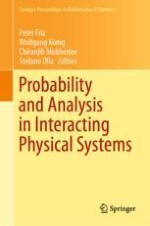2019 | OriginalPaper | Chapter
A Natural Probabilistic Model on the Integers and Its Relation to Dickman-Type Distributions and Buchstab’s Function
Author : Ross G. Pinsky
Published in: Probability and Analysis in Interacting Physical Systems
Publisher: Springer International Publishing
Activate our intelligent search to find suitable subject content or patents.
Select sections of text to find matching patents with Artificial Intelligence. powered by
Select sections of text to find additional relevant content using AI-assisted search. powered by
